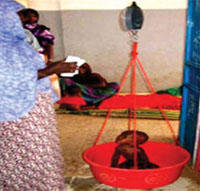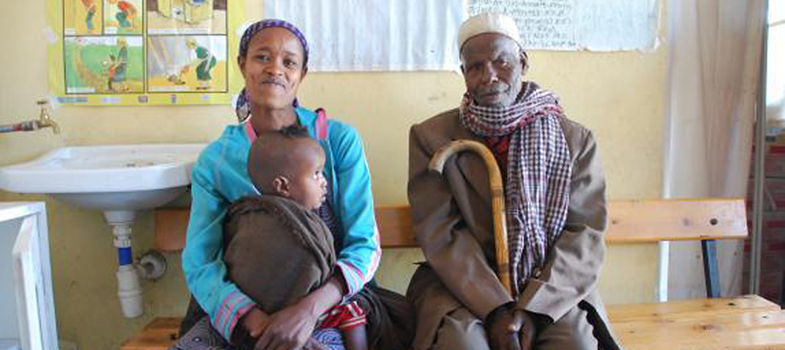7.3.4 Measuring a child’s weight
Knowing the child’s weight will be important for at least three reasons. It will enable you:
- To monitor the growth of a child over time using a standard WHO growth chart, and to counsel the mother on feeding if the child’s weight is found to be low.
- To evaluate the progress of a child who is receiving nutritional treatment in an outpatient therapeutic programme (OTP) or supplementary feeding programme (SFP). Baseline data for and subsequent follow-up of the child’s weight is therefore needed to decide the management of that child.
- To determine the dose of drug for the sick child.

Children are weighed by using a 25 kg hanging spring scale graduated to 0.1 kg (see Figure 7.4). You should not forget to re-adjust the scale to zero before each weighing. A plastic washing bowl should be attached by four ropes that go underneath the bowl. The bowl needs to be close to the ground in case the child falls out, and to make the child feel secure during weighing. If the basin is dirtied, then it should be cleaned with disinfectant. This is much more comfortable and familiar for the child; it can be used for ill children and is easily cleaned.
When the child is steady, record the measurement to the nearest 100 gm (the frame of the scale should be at eye level). Each day, the scales must be checked and calibrated by using a known weight. Suitable items for the calibration include a stone or a standard 5–10 kg weight. If the measure does not match the weight to within 0.01 kg, the scale should be replaced. Spring balance scales should be replaced whenever the springs become too stretched.
As a Health Extension Practitioner you are expected to determine the classification of a child for malnutrition on the basis of visible severe wasting, oedema and MUAC measurements, and to treat the child based on the presence or absence of these signs. Weight in particular is used for monitoring the child and when making a decision whether to discharge a child from an OTP.
7.3.3 Look and feel for oedema of both feet
